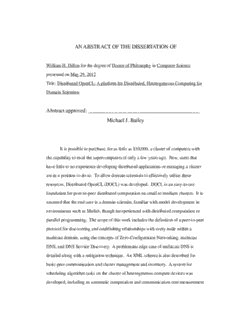Table Of ContentAN ABSTRACT OF THE DISSERTATION OF
William H. Dillon for the degree of Doctor of Philosophy in Computer Science
presented on May 29, 2012
Title: Distributed OpenCL: A platform for Distributed, Heterogeneous Computing for
Domain Scientists
Abstract approved: __________________________________________
Michael J. Bailey
It is possible to purchase, for as little as $10,000, a cluster of computers with
the capability to rival the supercomputers of only a few years ago. Now, users that
have little to no experience developing distributed applications or managing a cluster
are in a position to do so. To allow domain scientists to effectively utilize these
resources, Distributed OpenCL (DOCL) was developed. DOCL is an easy-to-use
foundation for peer-to-peer distributed computation on small to medium clusters. It is
assumed that the end-user is a domain scientist, familiar with model development in
environments such as Matlab, though inexperienced with distributed computation or
parallel programming. The scope of this work includes the definition of a peer-to-peer
protocol for discovering and establishing relationships with every node within a
multicast domain, using the concepts of Zero-Configuration Networking, multicast
DNS, and DNS Service Discovery. A problematic edge case of multicast DNS is
detailed along with a mitigation technique. An XML schema is also described for
basic peer communication and cluster management and inventory. A system for
scheduling algorithm tasks on the cluster of heterogeneous compute devices was
developed, including an automatic computation and communication cost measurement
system. Finally, a graphical programming language was designed and implemented
that allows non-expert programmers and modelers to develop new applications in a
straightforward, accessible way.
© Copyright by William H. Dillon
May 29, 2012
All Rights Reserved
Distributed OpenCL: A platform for Distributed, Heterogeneous Computing for
Domain Scientists
by
William H. Dillon
A DISSERTATION
submitted to
Oregon State University
in partial fulfillment of
the requirements for the
degree of
Doctor of Philosophy
Presented May 29, 2012
Commencement June 2012
UMI Number: 3528636
All rights reserved
INFORMATION TO ALL USERS
The quality of this reproduction is dependent on the quality of the copy submitted.
In the unlikely event that the author did not send a complete manuscript
and there are missing pages, these will be noted. Also, if material had to be removed,
a note will indicate the deletion.
UMI 3528636
Copyright 2012 by ProQuest LLC.
All rights reserved. This edition of the work is protected against
unauthorized copying under Title 17, United States Code.
ProQuest LLC.
789 East Eisenhower Parkway
P.O. Box 1346
Ann Arbor, MI 48106 - 1346
Doctor of Philosophy dissertation of William H. Dillon on May 29, 2012.
APPROVED:
__________________________________________________________
Major Professor, representing Computer Science
__________________________________________________________
Director of the School of Electrical Engineering and Computer Science
__________________________________________________________
Dean of the Graduate School
I understand that my dissertation will become part of the permanent collection of
Oregon State University libraries. My signature below authorizes release of my
dissertation to any reader upon request.
__________________________________________________________
William H. Dillon, Author
ACKNOWLEDGMENTS
I would like to first thank my wife Katie for being a patient and supportive partner.
Without her support, encouragement, and love this work would have never been
completed. In addition, I must thank my mother for the many years of support and
love and the rest of my family for being there for me. Finally, I want to thank Rachel,
my sister, for graciously lending her editing skills.
Secondly, I would like thank my advisor, Mike Bailey, for the support and
encouragement over the duration of my graduate career. I would also like to recognize
all of my committee members for their time and effort.
Thirdly, I would like to thank the fantastic research computing team at CEOAS. The
help provided by Chuck Sears, Tom Leach, and Bruce Marler, was indispensable.
Toms mastery of networking protocols is rivaled only by the implementers
themselves. The unique approach to research computing management fostered an
environment that allowed this work to take place. Had the team not been flexible and
understanding, it would not have been possible to complete this work.
Finally, I want to thank Mark Abbott for supporting this work, and providing an
environment in which it could be completed, and for financial support, Terri
Paluszkiewicz and the Office of Naval Research.
TABLE OF CONTENTS
Page
Introduction ...........................................................................................................1
Market Changes ..........................................................................................3
The end of clock rate increases ..........................................................7
Parallelism is the path forward. ..........................................................9
The widening gap between domain science and computer technology. .....11
Distributed OpenCL Overview .............................................................................13
Architecture. ................................................................................................15
Previous Work .............................................................................................18
Materials and Methods. ...............................................................................23
Peer Discovery, Resolution and Latency Measurement. .......................................29
Peer Discovery with DNS-SD ....................................................................30
Latency Measurement and mDNS Across Non-routed Subnets .................32
Peer To Peer Clustering .........................................................................................35
Protocol Details. ..........................................................................................37
TCP Peering protocol .........................................................................38
XML Messaging protocol and schema. ..............................................40
Results. ........................................................................................................47
Automatic Network Cost Measurement. ...............................................................50
TABLE OF CONTENTS (Continued)
Page
Theoretical Background and Previous Work ..............................................51
Methods. ......................................................................................................54
Mutual Exclusion using the TCP Handshake .....................................55
Distributed synchronization using local locks ...................................57
Results. ........................................................................................................61
Task Scheduling Framework for Heterogeneous Computing. ...............................64
Previous and Related Work .........................................................................65
Task graph representation and document format ........................................67
Task graph Classes and Structure. ......................................................67
XML Document Structure. .................................................................68
Automatic Computation Cost Benchmarking .............................................71
Scheduling Framework ...............................................................................73
Task Graph Execution .................................................................................75
Graphical Programming Language. .......................................................................78
Previous and Related Work .........................................................................78
Graphical Programming Language Design. ................................................82
Graphical Programming Language Implementation. ..................................86
Example problems solved with Distributed OpenCL. ...........................................89
Description:Gabe Newell of Valve Software recently said “If there were 500 people who could write a good game engine in the last generation, you’re really talking 50 people

